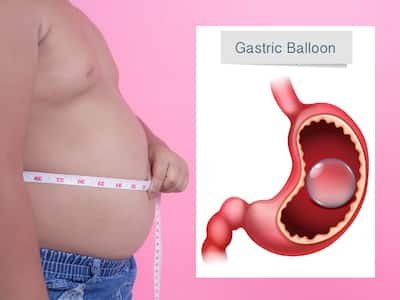
Struggling with obesity? Gastric balloon is a non-surgical approach to weight loss. Read on to know its advantages over other weight loss procedures.
The prevalence of obesity has reached alarming levels globally, necessitating the development of various weight loss strategies. One such strategy that is gaining popularity in recent days is the gastric balloon. Designed to support weight reduction, the gastric balloon offers a non-surgical approach for individuals struggling with obesity.
Dr. Neha Shah, Bariatric Surgeon specialist, Apollo Spectra Hospital, Chennai, explains what exactly a Gastric Balloon is, its benefits, side effects, and more.
What is a Gastric Balloon?
The gastric balloon, also known as the intragastric balloon, is a medical device inserted into the stomach to promote weight loss. It is a temporary measure that helps individuals jumpstart their weight loss journey. The balloon is typically made of soft and expandable material and is filled with either saline solution or air.
Benefits of Gastric Balloon
- Non-surgical Approach: Unlike other weight loss procedures such as gastric bypass or gastric sleeve surgery, the gastric balloon does not involve any incisions or permanent alterations to the digestive system.
- Effective Weight Loss: With the gastric balloon occupying space in the stomach, patients tend to eat smaller portions, leading to a calorie deficit and subsequent weight loss.
- Short Recovery Time: Since the gastric balloon procedure does not require surgery, the recovery time is relatively short. Within a few days, patients can usually return to their regular activities.
- Minimizes Risks: Gastric balloon surgery carries fewer risks and complications compared to invasive surgeries. Since it does not involve major surgical incisions or rerouting of the digestive tract, the procedure reduces the potential for complications such as infection, bleeding, or leaks.
- Reversible and Temporary: The gastric balloon is a temporary measure. It remains in the stomach for a predetermined period, usually around six months. Newer balloons can be kept in the stomach for a period of one year. After that time, the balloon is removed in a similar endoscopic procedure. This reversibility is an advantage for individuals who may want a temporary weight loss intervention or wish to assess their progress before considering more permanent surgical options.
Procedure
The gastric balloon procedure is quick and usually takes around 20 to 30 minutes to complete. Here is how it is done:
READ RELATED: Diet For Thalassemia Patients: Expert Shares What To Include In Your Plate
- Pre-Procedure Evaluation: Before the insertion of the gastric balloon, a thorough medical evaluation is conducted to ensure that the patient is a suitable candidate. This may involve physical examinations, blood tests, and imaging studies.
- Balloon Placement: The insertion of the gastric balloon is performed endoscopically, meaning it is done through the mouth and esophagus. The deflated balloon is guided into the stomach using a flexible endoscope, and once in place, it is filled with the appropriate fluid or air.
- Balloon Removal: The gastric balloon remains in the stomach for a predetermined period, typically around six months. At the end of this period, the balloon is removed in a similar endoscopic procedure.
Side Effects
While the gastric balloon is generally considered safe, there are a few side effects to be aware of. These include:
- Nausea and Vomiting: Some individuals may experience temporary nausea or vomiting in the initial days after balloon placement. This is primarily due to the stomach adjusting to the presence of the balloon.
- Gastric Discomfort: The presence of the gastric balloon may cause discomfort or a feeling of heaviness in the stomach. However, these sensations usually subside as the body adapts to the balloon.
- Ulceration or Erosion: In rare cases, the gastric balloon may cause ulcers or erosion in the stomach lining. This risk is minimized through proper patient selection and close monitoring during the balloon placement period.
- Reflux or Indigestion: Gastroesophageal reflux disease (GERD) or indigestion symptoms may occur in some individuals due to the presence of the balloon.
Conclusion
The gastric balloon offers an effective non-surgical option for individuals seeking weight loss. With its numerous benefits, including its non-invasive nature, effective weight reduction, and short recovery time, it has become a popular choice. However, Dr. Neha, notes that it is crucial to understand the potential side effects associated with the procedure.
Total Wellness is now just a click away.
Follow us on
window.addEventListener(‘load’, (event) => {
// $(document).ready(function(){
$(‘#commentbtn’).on(“click”,function(){
(function(d, s, id) { var js, fjs = d.getElementsByTagName(s)[0]; if (d.getElementById(id)) return; js = d.createElement(s); js.id = id; js.src = “//connect.facebook.net/en_US/sdk.js#xfbml=1&version=v2.3”; fjs.parentNode.insertBefore(js, fjs);}(document, ‘script’, ‘facebook-jssdk’));
$(“.cmntbox”).toggle();
});
// });
});






